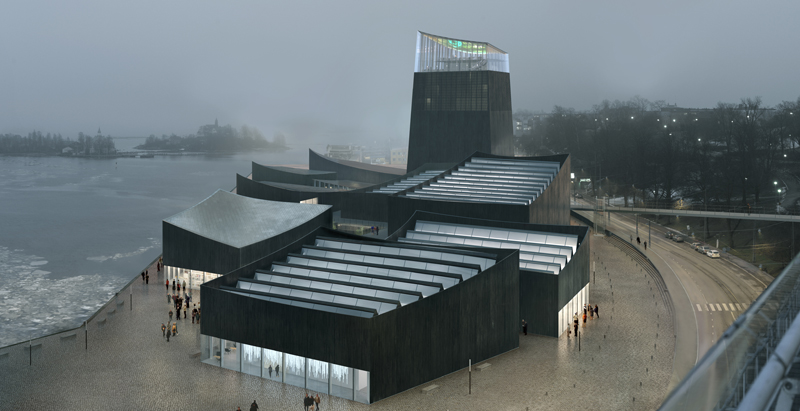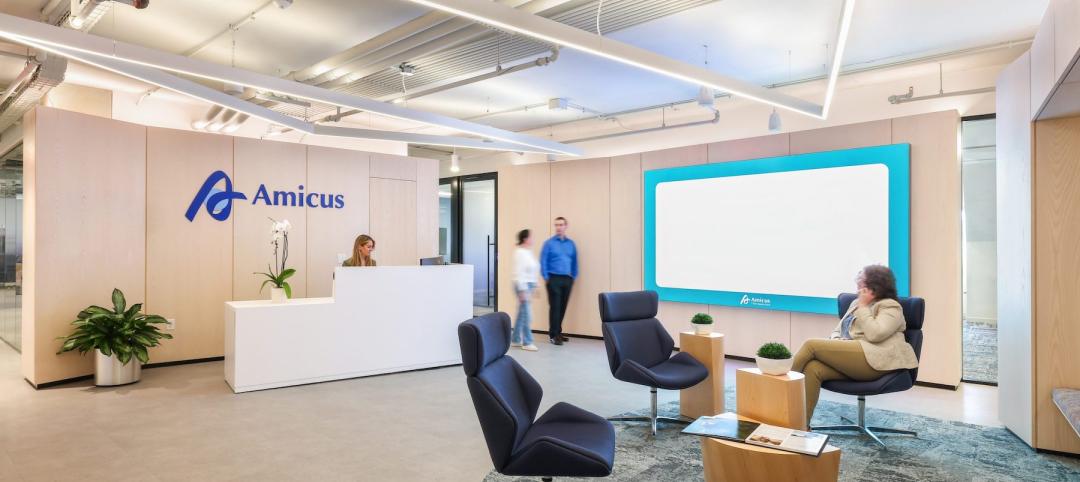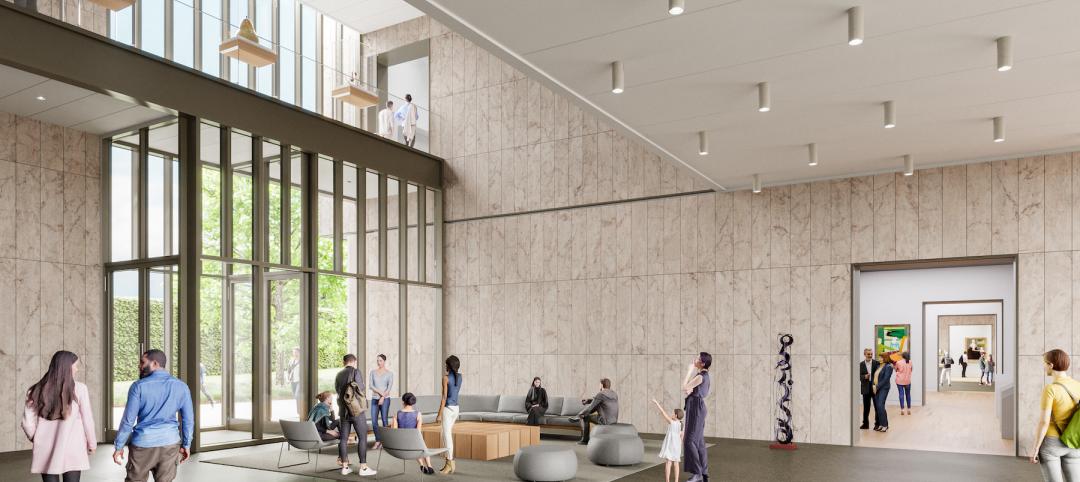The second-stage designs by finalists in the Guggenheim Helsinki design competition have been unveiled, Architectureau reports.
The designs were not released alongside the firm that created them. The renderings below are from the finalists: AGPS Architecture, Asif Khan Ltd., Haas Cook Zemmrich Studio2050, Moreau Kusunoki Architectes, SMAR Architecture Studio, and Fake Industries Architectural Agonism.
The team behind each design will remain anonymous until judging is complete. Designs are currently on exhibit at the Kunsthalle Helsinki. Additionally, exhibition visitors can play a Matchmaker Game, developed by American data scientist and taste researcher Hugo Liu, to pair visitors with one of the six final designs based on an assessment of their personality.
Following the exhibition, the jury will meet in Helsinki to select a winner, which will be announced on June 23, 2015.
Read more at Architectureau, and see all the renderings for each submission at Guggenheim Helsinki.
FINALIST #1

From the architects:
Five timber towers huddle together at the edge of the Baltic Sea, forming a shimmering beacon on the shoreline.
Multiple forms produce an interplay of light and shadow that create an inspiring, enticing atmosphere, while glimpses of in-between spaces beckon visitors from near and far. The warmth and familiarity of the wood shingle façade creates a sense of belonging with the landscape, while an ethereal quality is expressed through its subtle oscillation, ruffling, as though brushed by the winds of the sea. Helsinki Five seeks to engage a sense of discovery that is deeply informed by art, instigating close encounters between artwork and viewer, between art-maker and art-making.
It is a play of hide and seek, light and dark, wide and close, in and out.
FINALIST #2
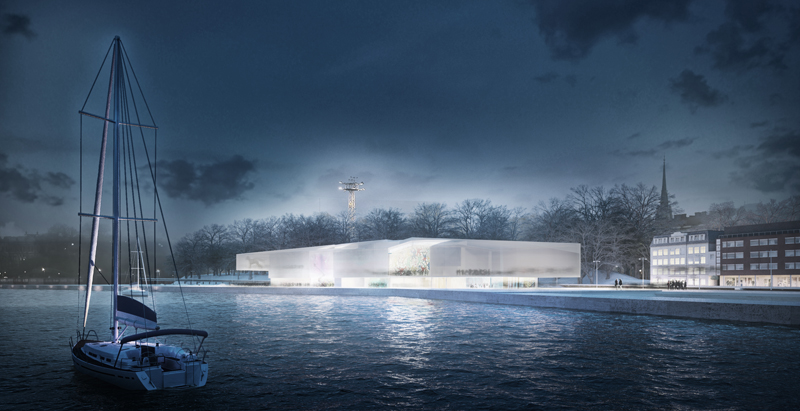
From the architects:
The use of Street Space forms the basis for basic social discourse, from political gatherings to Art creation or community expressions.
While an increasing “unofficial” art was blooming in the streets from the second half of the XX Century, Museums have been historically focused in Gallery Art, excluding Public Space production.
Future is “bottom up”. Museums have to change from institutions where information was directed in only one way: towards the viewer into institutions that are increasingly creating conversations with the citizen, prioritizing the human scale of a space over its merely sculptural value.
Due to its particular climatic conditions. There are 2 cities in Helsinki. Summer Helsinki and Winter Helsinki. We propose a Strategy that could offer back to the City an Interior Street, Public Space at no additional cost to be used also the 6 cold months of the year. The combination of 2 programs -The Museum -Gallery Art- and The Extra Space -Street Art- in a single building allows us to explore the relationship between 2 complementary worlds. Using both factors, we had the chance to add, subtract, divide… We decided to multiply.
FINALIST #3

From the architects:
Helsinki is a city of interiors. Due to its extreme climatic conditions, Helsinki’s civic society blossoms indoors. Our proposal for the Guggenheim Helsinki, 47 Rooms, extends this network using the architectural technologies that construct Helsinki’s interior citizenry: i.e. walls, doors, windows, and the machinery that defines atmospheric conditions.
47 Rooms contains nine rooms of 20x20m, twenty-seven of 6.5x6.5m six of 10x10m, two of 120x4m and one of 32x120m and three outdoor rooms. A multiplicity of chambers and climatic conditions will allow various museums to live together in the same building. The museum is ready to welcome individual visitors, families, local art scene, high school visits, young audiences, international tourists, groups of friends… 47 Rooms is a machine to provide singular and ever-changing experiences by opening and closing doors to different climates.
47 Rooms extends the logic through which Helsinki’s population already tempers their more intimate public spaces. Imitating the logic of the Sauna, each room’s final climatic conditions include certain degree of negotiation between the institution and its visitors.
47 Rooms means a strategic shift on Guggenheim’s identity: it embraces Helsinki focusing on interior climate rather than external appearance.
FINALIST #4

From the architects:
Our proposal takes the form of a Helsinki city block rotated to the harbourfront.
Seven timber-clad galleries are stacked over a basement and three levels flanked by administration and open-format halls. Public spaces are formed between these and an intelligent textured glass skin wrapping the entirety to precisely diffuse light, translucent below, and transparent above. The lower galleries join as needed, while the third floor is one super-space. The variety enables a wide range of curatorial approaches.
The museum’s three entrances are arrived at by new cobble and gravel walking routes. Centrally a wide, convivial staircase helps visitors wayfind intuitively. “Art Kioski” annex for young Nordic art twins the historic Kauppahalli while a sculpture garden is enclosed to the south.
In 1800s Helsinki city blocks were named after wild animals. The proposed new block will have the tactile familiarity of a pet’s fur. So we call this proposal “quiet animal."
FINALIST #5
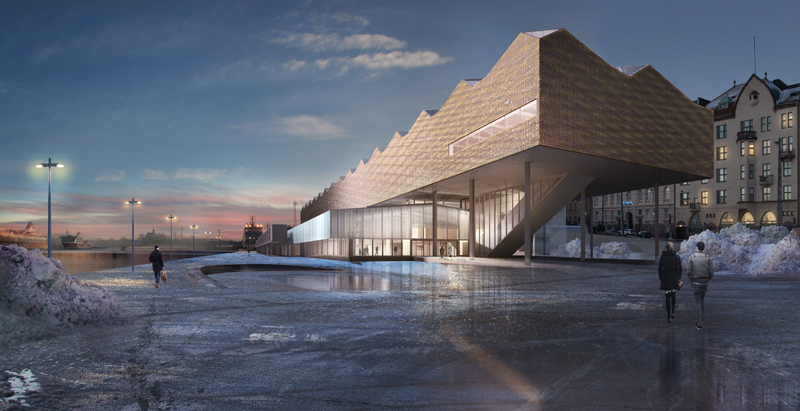
From the architects:
The museum is composed of two spaces - one for exhibitions, the other a public forum - that come together in a dance involving art and the city, gradually engaging in multiple movements, from a pas de deux, to a pas de trois, etcetera.
One space of the museum is on the dock level of the port facility, acknowledging the site’s industrial function as a vital memory for the new ensemble. Part gathering place, part community center, part incubator for innovation, it is conceived as a social commons within the city.
The other space of the museum houses art exhibitions. Hovering in the air, it offers a place for contemplation, with large open galleries, complementing its companion space below.
Greater than the sum of its parts, the museum generates multiple relations among people, architecture, and the arts. With this, the Guggenheim Helsinki can engage a broad constituency of stakeholders, benefiting not only the arts, but the public at large.
FINALIST #6
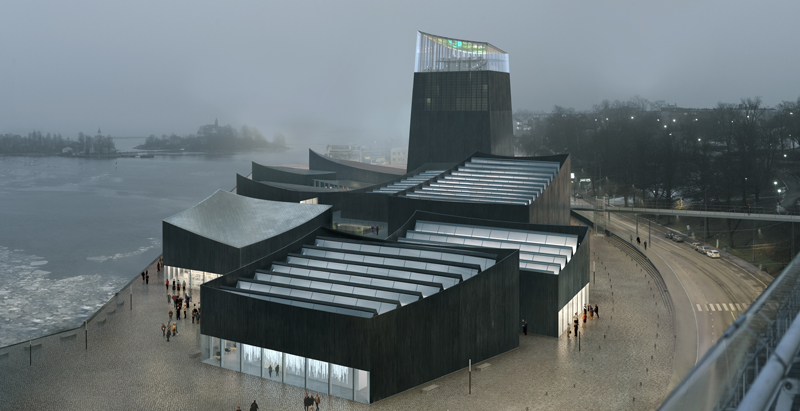
From the architects:
The design of the Guggenheim Helsinki and its woven landscape are based upon a sensitive and sympathetic approach to the context and nature of Helsinki. The design encourages people to flow within a new cultural core that is linked to the rest of the city, through the port promenade and the pedestrian footbridge to the Observatory Park. This flexible access welcomes not only the visitors but also serves as a key cultural destination for the community.
The museum skyline is composed by independent volumes, highlighted by a landmark tower. These fragmented art exhibition spaces allow strong integration with outdoor display and events, while the lighthouse offers a new perspective over the city. This new museum concept together with the charred timber façade echoes the process of regeneration that occurs when forests burn and then grow back stronger.
Related Stories
Museums | Oct 1, 2024
UT Dallas opens Morphosis-designed Crow Museum of Asian Art
In Richardson, Tex., the University of Texas at Dallas has opened a second location for the Crow Museum of Asian Art—the first of multiple buildings that will be part of a 12-acre cultural district. When completed, the arts and performance complex, called the Edith and Peter O’Donnell Jr. Athenaeum, will include two museums, a performance hall and music building, a grand plaza, and a dedicated parking structure on the Richardson campus.
Museums | Aug 29, 2024
Bjarke Ingels' Suzhou Museum of Contemporary Art conceived as village of 12 pavilions
The 60,000-sm Suzhou Museum of Contemporary Art in Suzhou, Jiangsu, China recently topped out. Designed by Bjarke Ingels Group (BIG), the museum is conceived as a village of 12 pavilions, offering a modern interpretation of the elements that have defined the city’s urbanism, architecture, and landscape for centuries.
Cultural Facilities | Aug 21, 2024
Baltimore’s National Aquarium opens 10,000-sf floating wetland that mimics the harbor’s original tidal marsh habitat
The National Aquarium in Baltimore has opened the National Aquarium Harbor Wetland, a 10,000-sf floating wetland that mimics the Inner Harbor’s original Chesapeake Bay tidal marsh habitat. Located between Piers 3 and 4 on Baltimore’s Inner Harbor, the $14 million project features more than 32,000 native shrubs and marsh grasses.
Museums | Aug 19, 2024
The Tampa Museum of Art will soon undergo a $110 million expansion
In Tampa, Fla., the Tampa Museum of Art will soon undergo a 77,904-sf Centennial Expansion project. The museum plans to reach its $110 million fundraising goal by late 2024 or early 2025 and then break ground. Designed by Weiss/Manfredi, and with construction manager The Beck Group, the expansion will redefine the museum’s surrounding site.
Museums | Jun 20, 2024
Connecticut’s Bruce Museum more than doubles its size with a 42,000-sf, three-floor addition
In Greenwich, Conn., the Bruce Museum, a multidisciplinary institution highlighting art, science, and history, has undergone a campus revitalization and expansion that more than doubles the museum’s size. Designed by EskewDumezRipple and built by Turner Construction, the project includes a 42,000-sf, three-floor addition as well as a comprehensive renovation of the 32,500-sf museum, which was originally built as a private home in the mid-19th century and expanded in the early 1990s.
Libraries | Jun 7, 2024
7 ways to change 'business as usual': The Theodore Roosevelt Presidential Library
One hundred forty years ago, Theodore Roosevelt had a vision that is being realized today. The Theodore Roosevelt Presidential Library is a cutting-edge example of what’s possible when all seven ambitions are pursued to the fullest from the beginning and integrated into the design at every phase and scale.
Headquarters | Jun 5, 2024
Several new projects are upgrading historic Princeton, N.J.
Multifamily, cultural, and office additions are among the new construction.
Museums | May 20, 2024
Museum design connects art, architecture, and nature
Three recent examples show how landscape views enhance exhibit space.
Cultural Facilities | Apr 8, 2024
Multipurpose sports facility will be first completed building at Obama Presidential Center
When it opens in late 2025, the Home Court will be the first completed space on the Obama Presidential Center campus in Chicago. Located on the southwest corner of the 19.3-acre Obama Presidential Center in Jackson Park, the Home Court will be the largest gathering space on the campus. Renderings recently have been released of the 45,000-sf multipurpose sports facility and events space designed by Moody Nolan.
Cultural Facilities | Mar 27, 2024
Kansas City’s new Sobela Ocean Aquarium home to nearly 8,000 animals in 34 habitats
Kansas City’s new Sobela Ocean Aquarium is a world-class facility home to nearly 8,000 animals in 34 habitats ranging from small tanks to a giant 400,000-gallon shark tank.


